This post contains no spoilers for The Return of the Obra Dinn, but I do detail some specifics about the nuts and bolts of the core gameplay loop.
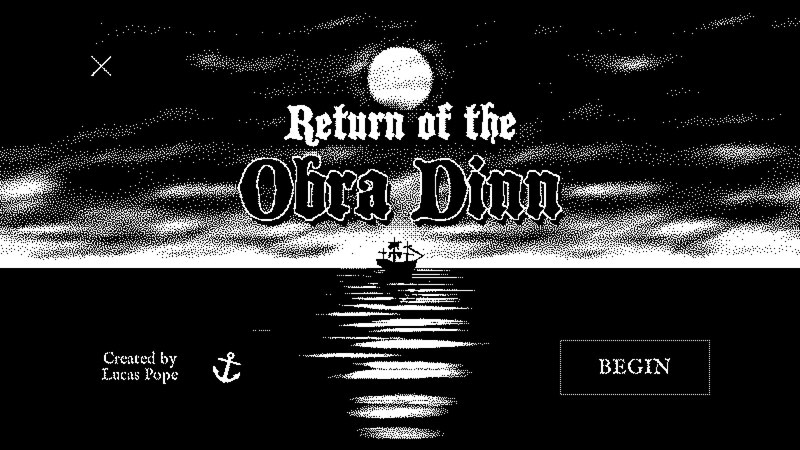
I quite enjoyed my time with Obra Dinn. Steam reports the game took me about ten hours to solve, spread across two long-ish play sessions, immersed in the only fully 3D 1-bit world I’ve ever explored to a cacophony of strings and brass. It’s an enthralling story of monsters, betrayal, and grand adventure on the high seas. From a strictly artistic standpoint, this game is worth the asking price.
I don’t buy games for strictly artistic reasons, though. I buy games to play games. And this is where Obra Dinn has a critical flaw.
The flaw isn’t that it’s a… (groan)… walking simulator. Yes, all you can do in this game is walk around and look at things. Yes, your world interactions are limited to opening doors, waving your pocket watch around, and entering data into your 19th century spreadsheet. This is what separates it from more conventional adventure games; there aren’t any puzzle boxes or strange ciphers, there’s no inventory, no branching dialogue trees, no key-and-lock. It’s neither Monkey Island nor Myst. The actual experience of playing Obra Dinn is much like poring over an artistic puzzle book, clues hiding on every page, designed so that you just “know” you’ve solved everything, because there’s only one way the solution can go.
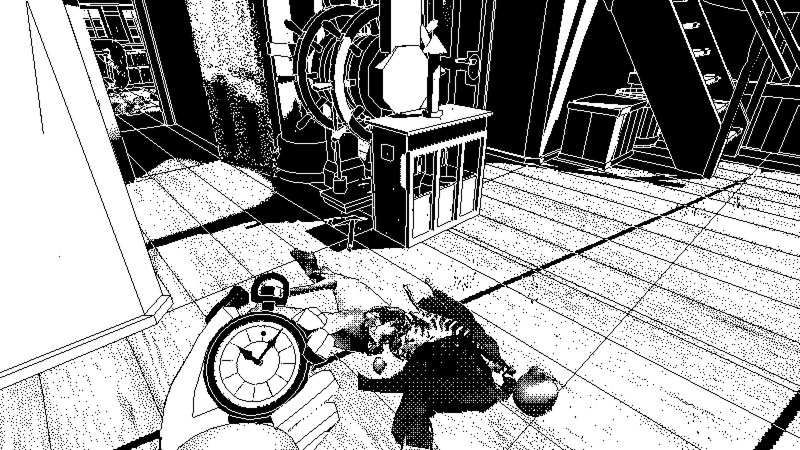
“My magic pocket watch will help determine who left this gross old skeleton here!”
I’m groaning about nothing, probably. At time of writing, Obra Dinn doesn’t even have “walking simulator” listed as a Steam tag. Although Obduction does. So maybe I’m the one who doesn’t know what the term’s supposed to mean. Point is, gameplay that happens in the blob between your ears is still gameplay. And Obra Dinn has that in spades.
The goal of the game is to correctly identify the face and fate of every lost soul aboard the ill-fated Obra Dinn, armed with only a crew manifest and a sketch of daily life aboard the ship. To this end you have a magic pocket watch which, when pointed at a dead person, transports you to a motionless snapshot of that person’s death. One frozen moment in time, with powder and blood spray and sea foam hanging in midair, where you’re meant to wander about and add to your growing book of deductions.
You’re doing detective work. Magical detective work, sure, but still a far cry from plugging a date you’ve read off a plaque behind a breakaway stairwell into a dentist chair to load up a specific star chart. You have to notice things about the snapshots you explore. You have to build a timeline, carefully place who’s who and what’s where. You have to trace ballistic trajectories, sometimes be-tentacle’d trajectories. And slowly, over time, your deductions and logical guesses will start to bear fruit, as you check names off your list and match them up with their tragic fates.
The game warns you that, sometimes, you have to make inferrences based on partial information. Just as an example: there are only four women aboard the ship. Two are identified by name, and that’s your lot. I spent a lot of the game waiting for a second clue to split the other ladies apart, before having a sudden “aha!” moment and realizing the clue I was waiting for was in front of me all along. I plugged in my deduction, and was right on both counts. A clever and illuminating moment! The important bit — the bit that makes me clever here — is that while it was an inferrence on my part it was a deductive inferrence. I logically decided which woman was which, and knew I was right before I placed them. It wasn’t a guess.
And this brings us to the critical flaw at last: I could have guessed. And gotten it right. And then I wouldn’t have felt clever at all, just… well, unsatisfied. Guessing isn’t fun, but it’s how I solved a decent percentage of this game, just as I imagine most players will. Across all players, Obra Dinn is probably 30% guesswork by volume.
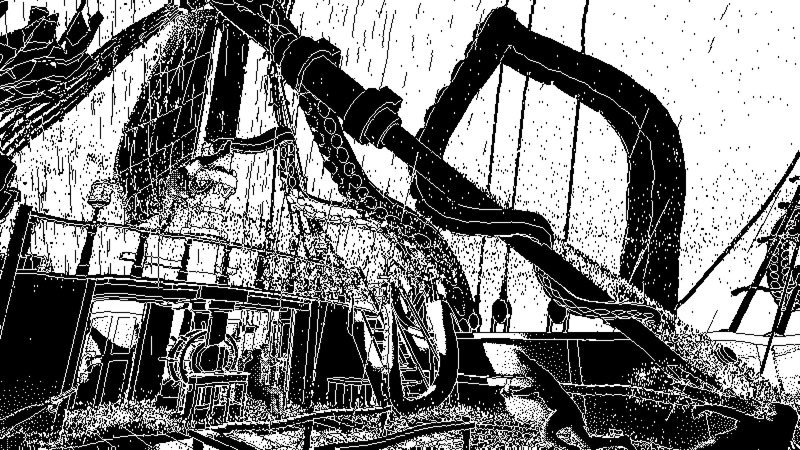
“I’m gonna guess… the kraken did it.”
Obra Dinn isn’t so mean as to require you have every soul bagged and tagged before allowing victory. Instead, when you have three people correctly marked, the game “locks them in”. This is two very important pieces of information: one, it’s the game telling you point blank, “Hey, here’s three you got right!”. Information puzzles need checks and gates like this, it’s nothing new. You know you have three pieces of information right in Myst when you plug the three symbols you got from those dentist chair star charts into a machine and it does something good.
The other piece of information you get, though, is, “Everything else you have penciled in is wrong!” And this is a lot more information than the game should probably give you. (It’s certainly more information than our intrepid watch-weilding insurance agent would have, in-universe. Muh ‘mersion!) Part of the thrill of this style of game, for me, is the realization that I’m on the wrong line of reasoning. It’s the creeping sense of bewilderment that sets in after playing with a dentist chair for an hour, abandoning what I thought I knew and setting out to scour for more information. You never get that in Obra Dinn, though, because the game explicitly tells you what you’re wrong about, constantly.
Adventure games are always open to brute forcing eventually. If you only identify two of the three needed star charts, you can figure out what the last one is just by running down the remaining possibilities. That’s in Myst, of course, but it applies to other adventures as well. In Monkey Island you can get unstuck by rubbing every inventory item over everything in the game world. This isn’t fun, by the way, but it’s how everyone plays Monkey Island because it becomes the most efficient way to progress, very quickly.
And you can play Obra Dinn like that. There are four women, three Russians, three midshipmen. If you can’t figure out which is which, just keep swapping their names around until the game tells you you’re right. The way this worked for me, in practice, is I’d scour the ship for clues of whatever deduction train I was currently following, and when something clicked I’d go in and switch around all my Russkies and Chinamen. Instead of locking in three well-researched souls at a time, I’d lock in one plus two mostly-lucky freebies.
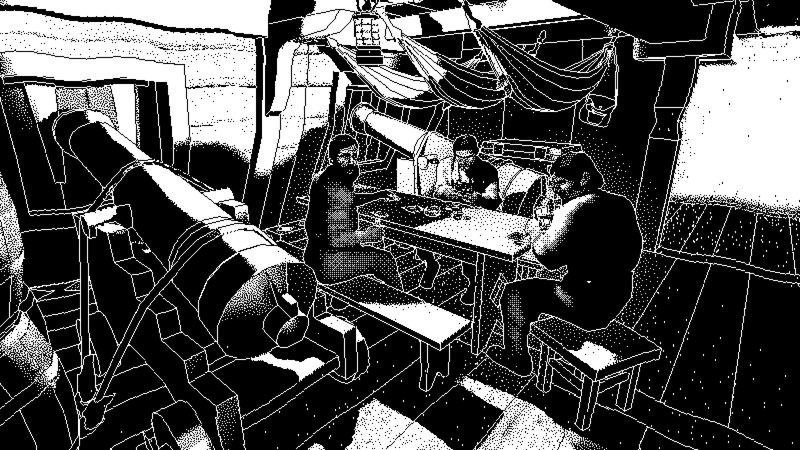
“Can you hurry up and switch us quick? All I have is a pair of 3s.”
So this sounds like a failing on my part. It’s not, for two reasons. First, you kind of stumble into this “strategy” by necessity. You have to pencil in guesses sometimes, because you have enough information to apply a name to, say, one of three faces, but not enough to definitively pin someone. Maybe there is more information out there, some obscure clue to find, but the game doesn’t let you find it because it turned your “maybe” into a “close enough!” without your consent.
And second, well, I still ended up doing a lot of really tricky detective work. By the end of my voyage I was down to following individual crewmen through their timelines, one snapshot at a time, building a mental map of where they were in relation to the action of every scene. This was quite taxing, but also very rewarding. The freebies weren’t really freebies so much as, like, a BOGO sale.
But the guessing is still a critical flaw, because it meant the game ended before I was really done with it. I felt like I had reached the second layer of required detective work in Obra Dinn, and only identified the third. If the game hadn’t been so diligent about locking in stuff I hadn’t started focusing on yet, I would have had to dig deeply into that third layer. It would have entailed correlating timelines across multiple characters and groupings of characters, and who knows what enjoyment I may have found there? What little character moments and plotlines and details?
This would be a very, very hard problem to solve. If the game did make you fill the information in for all crew before checking your work… what then? Well, there are a few details I know I would have gotten wrong, that I only knew were wrong because the game didn’t lock them, and had a great amount of fun going back to check what I missed. There’s a big difference between looking at a scene, looking closer, and looking really close, and I’d never have done the latter unless I knew I was in a failure state. I was also happy to get the little encouraging victory moments as I progressed, getting a little closer to my goal with each investigation. If I’d had to take the game as one giant lump I would have probably plugged away for ten hours, been unsure about a lot of my deductions, and then gotten many of them wrong anyway. And then I’d be writing a post about some neat-looking but really stupid game I’d played.
Perhaps you could add a third criteria. You pick the names and causes of death from drop-down menus in your spreadsheet; maybe if I’d have had to prove I knew whow was who by pointing to specific evidence, and then lock it in, the guessing problem would’ve be averted. There already is some mechanism by which the game determines whether you “know” enough to determine a person’s identity… but you’d need a dropdown with hundreds of keywords to provide enough red herrings that the list itself doesn’t provide clues. And then I’d still probably just read the whole list anyway, and correlate it with keywords I’d recognized around the ship, and attacking the game from a list of keywords doesn’t sound any more fun than guessing.
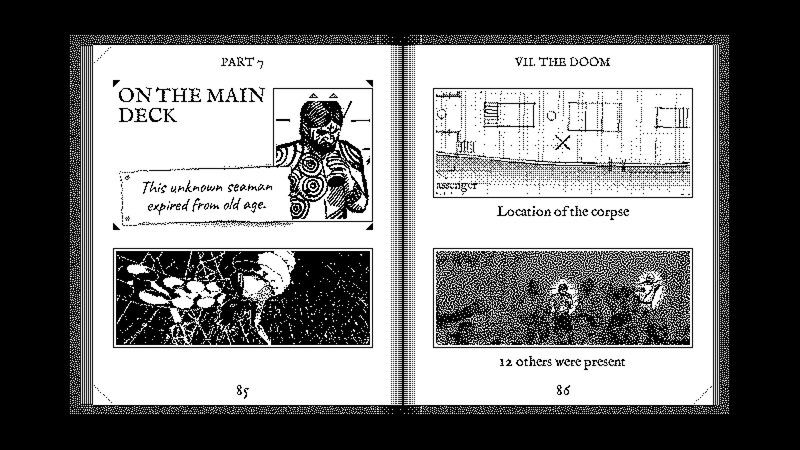
“Wait, they all died of old age?” “Yeah, it was a very old ship.”
Yeah, hard problem. But I hope somebody solves it someday, because The Return of the Obra Dinn was a really memorable C+, and I’d love to see this concept turned into an A.
Last detective game I said that about was L.A. Noire, and nobody’s solved those problems yet either. Maybe detective games are just hard to make.
Thanks for reading!
Some of the Wadjet Eye games and Her Story use a system where you have to put in a search term on a computer to pull up clues, which is unguessable – if the puzzle’s been built right, putting in a close enough search term will get you an actionable clue.
Her Story, incredibly, does this where the search is based on words in the script, and yet there’s still somehow an arc to it. The problem is that Her Story is, at its heart, only one mystery. Once you work out the trick it’s mostly following new dialogue to the part where the subject explains what’s really going on.